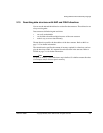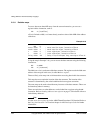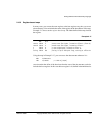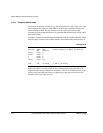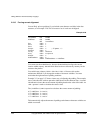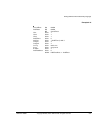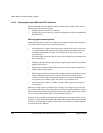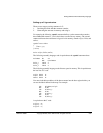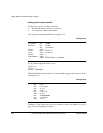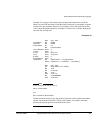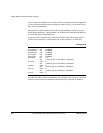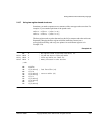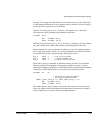
Writing ARM and Thumb Assembly Language
2-58 Copyright © 2000, 2001 ARM Limited. All rights reserved. ARM DUI 0068B
2.10.6 Using register-based MAP and FIELD directives
Register-based
MAP
and
FIELD
directives define register-based symbols. There are two
main uses for register-based symbols:
• defining structures similar to C structures
• gaining faster access to memory sections described by non register-based
MAP
and
FIELD
directives.
Defining register-based symbols
Register-based symbols can be very useful, but you must be careful when using them.
As a general rule, use them only in the following ways:
• As the location for a load or store instruction to load from or store to. If
Location
is a register-based symbol based on the register
Rb
and with numeric offset, the
assembler automatically translates, for example,
LDR Rn,Location
into
LDR
Rn,[Rb,#offset]
.
In an
ADR
or
ADRL
instruction,
ADR Rn,Location
is converted by the assembler into
ADD Rn,Rb,#offset
.
• Adding an ordinary numeric expression to a register-based symbol to get another
register-based symbol.
• Subtracting an ordinary numeric expression from a register-based symbol to get
another register-based symbol.
• Subtracting a register-based symbol from another register-based symbol to get an
ordinary numeric expression. Do not do this unless the two register-based
symbols are based on the same register. Otherwise, you have a combination of
two registers and a numeric value. This results in an assembler error.
• As the operand of a
:BASE:
or
:INDEX:
operator. These operators are mainly of
use in macros.
Other uses usually result in assembler error messages. For example, if you write
LDR
Rn,=Location
, where
Location
is register-based, you are asking the assembler to load
Rn
from a memory location that always has the current value of the register
Rb
plus offset
in it. It cannot do this, because there is no such memory location.
Similarly, if you write
ADD Rd,Rn,#expression
, and
expression
is register-based, you are
asking for a single
ADD
instruction that adds both the base register of the expression and
its offset to
Rn
. Again, the assembler cannot do this. You must use two
ADD
instructions
to perform these two additions.




